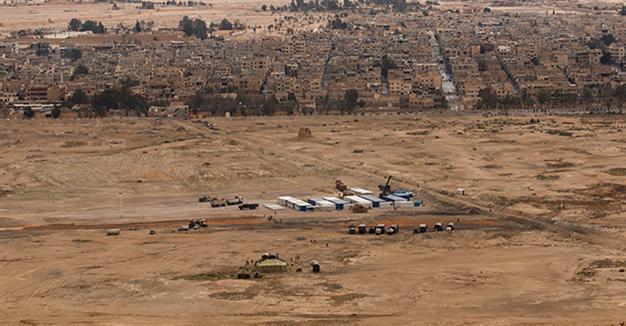Russians building army base at Syria's Palmyra site
BEIRUT - Associated Press

In this Thursday, April 14, 2016 photo, a Russian military camp is seen at the ancient city of Palmyra in the central city of Homs, Syria
The Russian military is constructing a new army base in the central Syrian town of Palmyra, within the protected zone that holds the archaeological site listed by UNESCO as a world heritage site and without asking for permission from relevant authorities, an American heritage organization and a top Syrian archaeologist said May 17.
The American School of Oriental Research's Cultural Heritage Initiative posted pictures from the satellite imagery and analytics company DigitalGlobe that show the construction on the edge of the ancient site that was damaged by the Islamic State of Iraq and the Levant (ISIL) group, which held Palmyra for 10 months.
Syrian troops backed by Russian airstrikes captured Palmyra in March and fighting continues miles away until this day.
Russian demining experts have detonated hundreds of bombs left behind by the extremists at and near the site since the town was captured. A top Syrian archaeologist said the presence of Syrian and Russian troops in Palmyra is important to prevent ISIL from coming back.
Maamoun Abdulkarim, head of the Antiquities and Museums Department in Damascus, told The Associated Press that the Russians are building small barracks that includes offices and clinics.
Abdulkarim said his organization was not asked for permission but added that ISIL is close to the town and the presence of Russian and Syrian troops is important to ensure that the site remains in government hands.
"We refuse to give permission even if it was for a small room to be built inside the site whether it is for the Syrian army, Russian army or anyone else," Abudlkarim said by telephone from Damascus. "We will never give such permission because this will be in violation of the archaeology law."
Since Russia began launching airstrikes in Syria in September 2015, Moscow has tipped the balance of power in favor of President Bashar Assad's forces. Earlier this year Russia said it was scaling back its presence in Syria.
Before ISIL captured the town in May 2015, the Syrian army was known to have minor military presence inside the site.
During the ISIL's 10 months in Palmyra, the militants destroyed the Temple of Bel, which dated back to A.D. 32, the Temple of Baalshamin, which was several stories high and fronted by six towering columns, and the Arch of Triumph, which was built under the Roman emperor Septimius Severus between A.D. 193 and A.D. 211.
"During the time of war, sometimes archaeological authorities don't have a say but security decisions dictate the orders," AbdulKarim said. "Once the situation improves and peace is reached, then we will openly call for removing" the barracks.
Osama al-Khatib, a Syrian opposition activist from Palmyra who currently lives in Turkey, said the Russians are setting up prefabricated homes and tents on the northern edge of the archaeological site. He added that the site where the Russians are now based is hundreds of meters (yards) from the temples and the Arch of Triumph.
He said there are also some historical graves near where the Russians are setting up their barracks.
